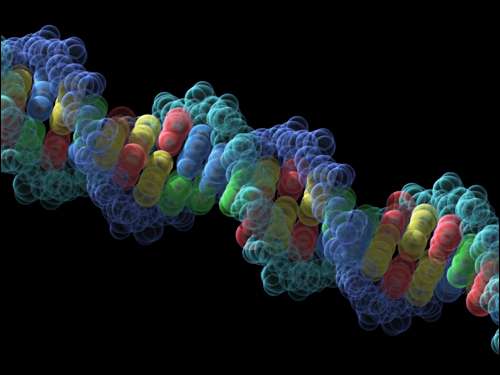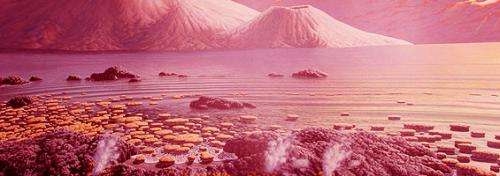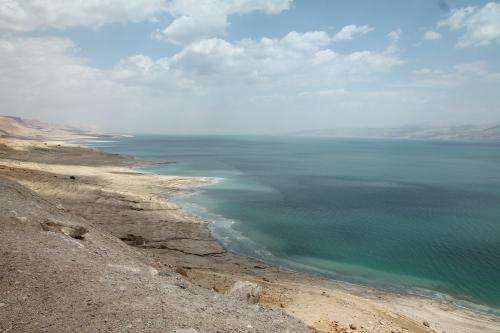DNA may have had humble beginnings as nutrient carrier

New research intriguingly suggests that DNA, the genetic information carrier for humans and other complex life, might have had a rather humbler origin. In some microbes, a study shows, DNA pulls double duty as a storage site for phosphate. This all-important biomolecule contains phosphorus, a sometimes hard-to-get nutrient.
Maintaining an in-house source of phosphate is a newfound tactic for enabling microorganisms to eke out a living in harsh environments, according to a new study published in the open-access, peer reviewed scientific journal PLOS ONE. The finding bodes well for life finding a way, as it were, in extreme conditions on worlds less hospitable than Earth.
The results also support a second insight: DNA might have come onto the biological scene merely as a means of keeping phosphate handy. Only later on in evolutionary history did the mighty molecule perhaps take on the more advanced role of genetic carrier.
"DNA might have initially evolved for the purpose of storing phosphate, and the various genetic benefits evolved later," said Joerg Soppa, senior author of the paper and a molecular biologist at Goethe University in Frankfurt, Germany.
Unraveling life's origins
Scientists continue to investigate the development of self-replicating, intricate sets of chemistry—in other words, life—from the chemical compounds thought available on early Earth. Out of this mixture of prebiotic chemicals, two nucleic acids—RNA and DNA—emerged as champions.
Today, these two types of biomolecules serve as the genetic information carriers for all Earthly biota. RNA on its own suffices for the business of life for simpler creatures, such as some viruses. Complex life, like humans, however, relies on DNA as its genetic carrier.
Astrobiologists want to understand the origin of DNA and its genetic cousin, RNA, because figuring out how life got started here on Earth is key for gauging if it might ever develop on alien planets.
Many researchers think RNA must have preceded DNA as the genetic molecule of choice. RNA is more versatile, acting as both genetic code and a catalyst for chemical reactions. Explicating the rise of DNA as a genetic material directly from RNA, however, is tricky. Compared to RNA, DNA needs significantly more supporting players for it to work well in a biological setting.
"The switch from RNA to DNA is not easy because many additional enzymes are required for DNA genomes," said Soppa.
This unclear transition from RNA to DNA opens the door for a precursor to DNA possibly having a more mundane job. The new study offers an attractive explanation: that DNA was a fancy way to store nutrients in cells.
Phosphate depot?
DNA is chock-full of phosphate. Cells depend on phosphate to form not only DNA and RNA, but also related genetic machinery, such as the ribosome. Phosphate, furthermore, is a must for building the molecule ATP, life's energy carrier, as well as fatty membrane molecules, certain phospho-proteins and phospho-sugars, and more.

"Phosphate is important for an immense set of biomolecules," said Soppa.
Unfortunately for some microbes, ample phosphate is not always available. For example, in salty, nutrient-poor habitats, such as the Dead Sea in the Middle East, an organism called Haloferax volcanii must regularly "eat" ambient DNA to obtain phosphate (plus some other nutritional goodies, such as nitrogen).
Notably, H. volcanii can still survive and reproduce when phosphorus, the element needed to make phosphate, is lacking. Somehow, then, the microbe must turn to an inner source of phosphate, for otherwise it should cease to grow.
In their study, Soppa and colleagues from Germany, the United States and Israel sought out this source. The nature of H. volcanii provided some clues. The organism is classified as archaea, one of the three domains of life, in addition to bacteria and eukarya, the latter encompassing all multicellular organisms, from fungi to fruit flies. Many archaea and bacteria—collectively, "prokaryotes"— have just one, circular chromosome. Eukaryotes, like us, on the other hand, can have any number of the chunky pieces of DNA, RNA and proteins. (Humans have 23 pairs of different chromosomes, for the record.) H. volcanii is unusual. It has 20 copies of the same chromosome when it's growing happily under favorable conditions, and 10 when nutrients are exhausted and it reaches a stationary phase.
Strength in numbers
Lots of chromosome copies are good to have in a pinch. So-called polyploidal organisms like H. volcanii use their copious chromosomes to tough it out through bad situations, such as high radiation exposure or total dry-outs, called desiccation. Either scenario causes the strands in chromosomal DNA to break. For single-chromosome species, only a few breaks lead to death because it is impossible to repair a chromosome scattered into fragments.
But if there are multiple copies of the cracked chromosomes, fragments can fortuitously line up. Rather like how a jigsaw puzzle is easier to put together if there are numerous duplicates of each necessary piece, the chromosome shards can sync up and restore a functional chromosome.
"In polyploid species, the fragments generated from different copies of the chromosome overlap, and it is possible to regenerate an intact chromosome from overlapping fragments," said Soppa.
Desperate times, desperate measures

To investigate if H. volcanii's extra chromosomes might help the archaeon survive low phosphate conditions, Soppa and colleagues starved the organism in the lab of the critical substance. The microbe continued to reproduce by splitting one cell apart into two. Interestingly, chromosome counts diminished in the "parent" and the "daughter" cells.
"From quantifying the number of chromosomes prior to and after growth in the absence of phosphate, we have found that about 30 percent of the chromosomes are 'missing' afterwards," said Soppa.
The numbers for another potential in-house source of phosphate, H. volcanii's ribosomes, however, remained steady. The most likely explanation, then, of the microorganism's hardiness when facing a phosphate nutrient shortage: H. volcanii simply cannibalizes some of its own chromosomes.
As further verification, Soppa and colleagues tested the survival skills of H. volcanii cells that contained varying numbers of chromosome copies. Those archaea with just two copies of their chromosome turned out to be more than five times as sensitive to desiccation as those H. volcanii with a hefty complement of 20 chromosomes.
Life, undaunted
This newly described benefit of polyploidy in H. volcanii is a fresh demonstration of how life can make do in severe environments. So-called extremophiles have been discovered in recent decades thriving in strongly acidic hot springs, within liquid asphalt, and in other eyebrow-raising niches. Salt-tolerant bacteria and archaea, like H. volcanii, have been found to survive in deserts, simulated Mars conditions, and even the rigors of a space flight. We should not be surprised, perhaps, if life has managed to take hold on formidable worlds.
"The understanding of how harsh the conditions can be that can be survived by some archaea and bacteria helps us to be more optimistic that life could have evolved at very rough and unsuitable places on early Earth or on other planets," said Soppa.
The new role ascribed to DNA, as phosphate storage, might help to explain how a completely RNA-dominated primordial era began sharing genetic duties with DNA. Life did not leap from RNA to DNA. Rather, DNA, slowly but surely, learned new tricks.
"The hypothesis that DNA might have evolved as a storage polymer and became genetic material later, makes the step from RNA to DNA as genetic material easier, because it then would be a two-step and not a one-step process," said Soppa. "DNA would have been around, and during long time spans additional roles could have been evolved."
More information: The study is available online: www.plosone.org/article/info%3Adoi%2F10.1371%2Fjournal.pone.0094819
Journal information: PLoS ONE
Source: Astrobio.net
This story is republished courtesy of NASA's Astrobiology Magazine. Explore the Earth and beyond at www.astrobio.net .


















